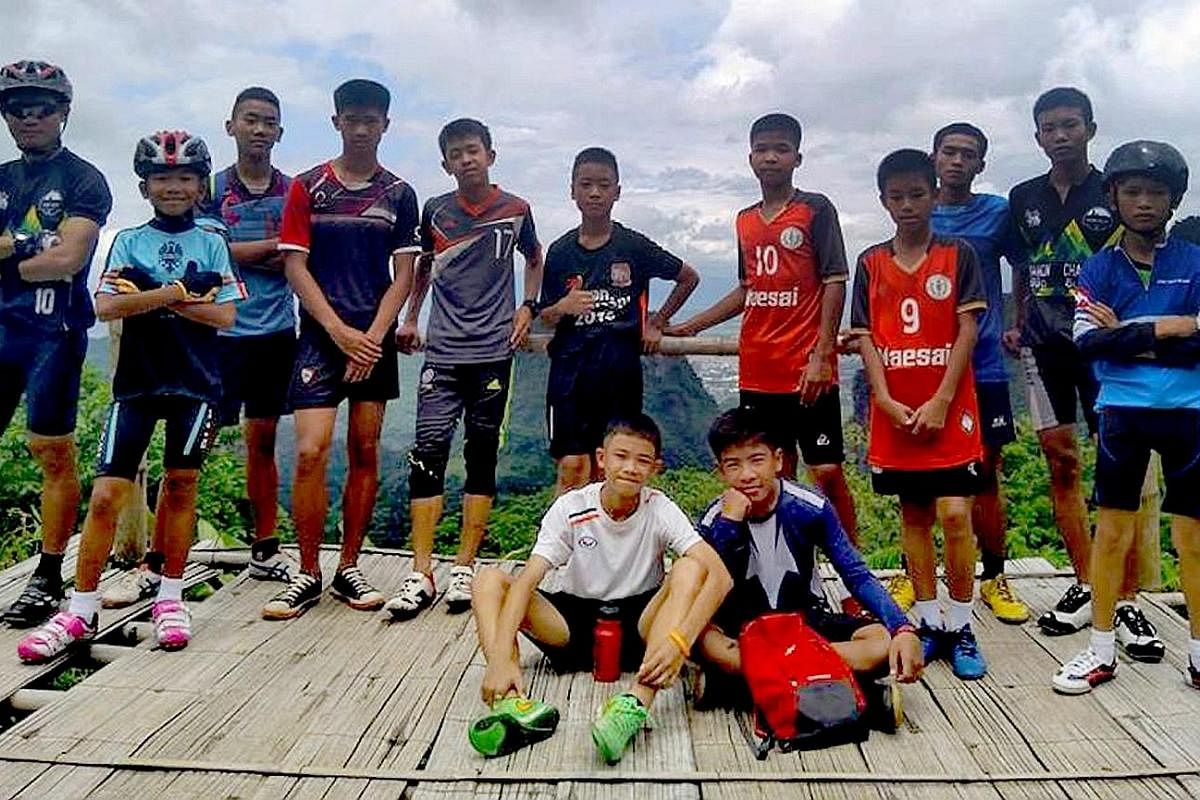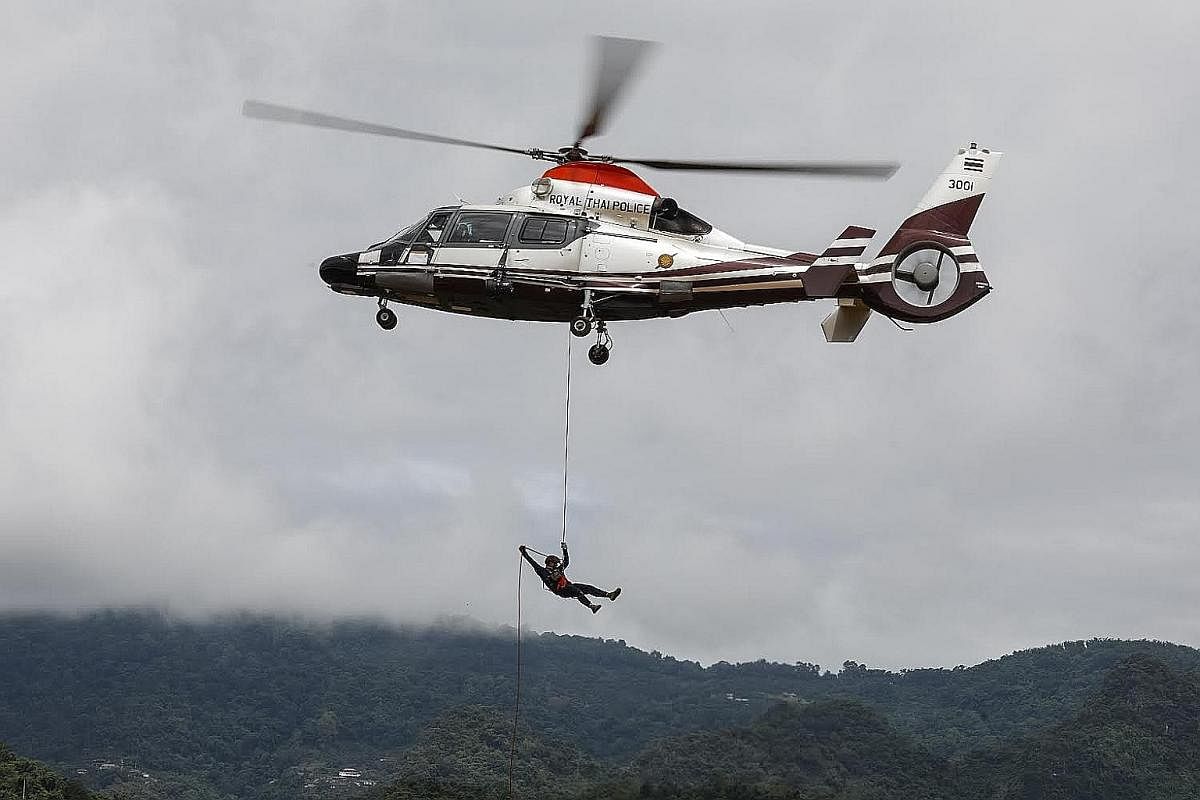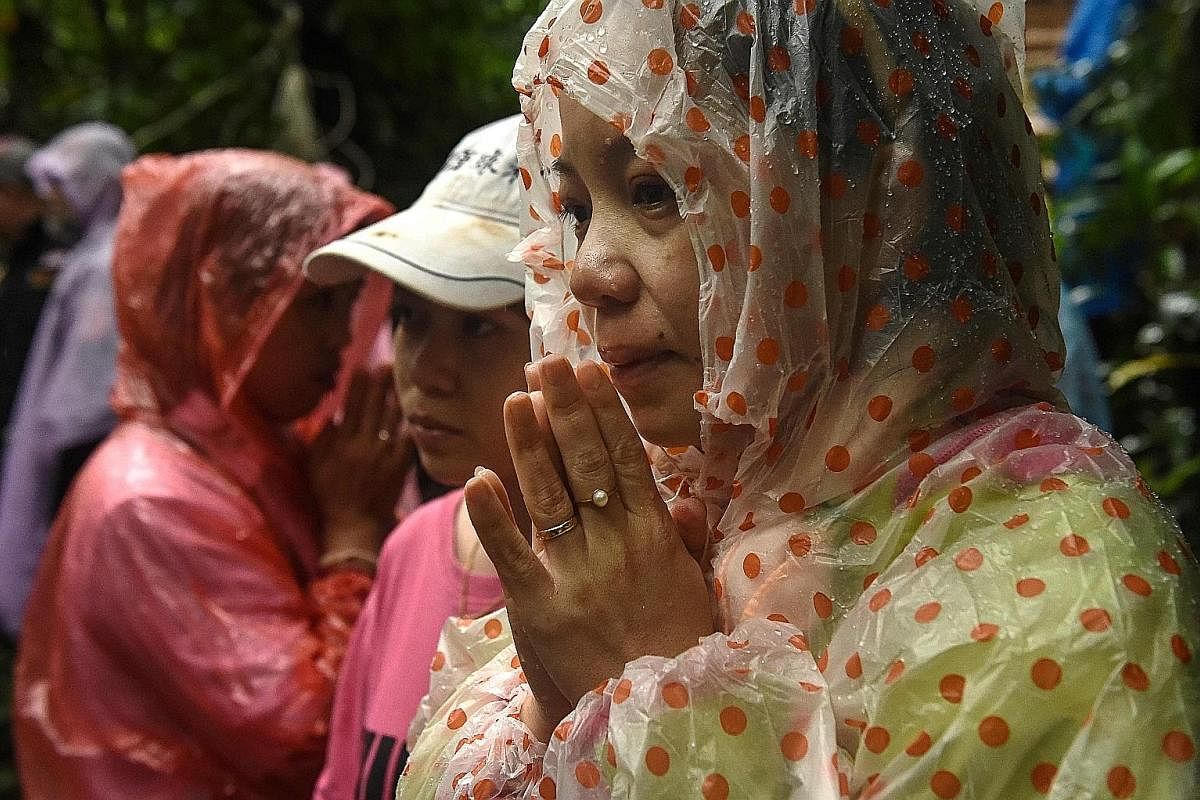-
THE SEARCH EFFORT
-
JUNE 23: Park officials search for the missing Thai youth football team on foot and find parts of the cave flooded. Some of the team's belongings are found left at the cave entrance.
 Bicycles belonging to the missing football players at the entrance of Tham Luang cave in Chiang Rai province, Thailand, on Tuesday. PHOTO: EPA-EFE
Bicycles belonging to the missing football players at the entrance of Tham Luang cave in Chiang Rai province, Thailand, on Tuesday. PHOTO: EPA-EFE JUNE 24: Local rescue workers begin diving in floodwaters in the cave, finding more belongings.
JUNE 25: Thai Navy Seals step in, blasting a wall section of the cave, but search efforts are halted due to low oxygen levels.
JUNE 26:
• Relatives gather at cave entrance awaiting news.
• Pumps are installed to reduce the water levels.
• An underwater robot and drones are deployed.
• Soldiers and police mobilised to scour the cave and search nearby areas for cave shafts.
JUNE 27 :
• Pumps start working effectively, but their capacity is overwhelmed by heavy downpours.
• Rescue teams continue looking for shafts that might connect to the cave.
JUNE 28:
• US forces and British divers arrive to help.
• Water is pumped out, but the pumps cannot keep up as rainfall continues.
• A spot near the cave wall is drilled in an effort to drain the floodwaters from inside.
 Rescue workers pumping water out of the cave on Thursday. However, the pumps could not keep up as rainfall continued. PHOTO: EPA-EFE
Rescue workers pumping water out of the cave on Thursday. However, the pumps could not keep up as rainfall continued. PHOTO: EPA-EFE
JUNE 29• Police drop survival packages through a shaft drilled in the mountainside, hoping it would reach the missing team.
JUNE 30
• Navy Seal divers nearly reach a T-junction in the depths of the cave just 2km or 3km from where the boys are believed to be.
• Police paratroopers climb down a shaft in search of a passage to the cave's main hall.
• Medics and police stage practice drills to prepare for the complex evacuation if the team is found.
SOURCE: THE NATION/ASIA NEWS NETWORK, AGENCE FRANCE-PRESSE, REUTERS
Missing Thai boys: Still no sign after a week
Rescuers hold out hope that the missing Thai boys have found a safe place inside cave




CHIANG RAI (Thailand) • On a sunny Saturday a week ago, after their usual morning practice, a dozen members of the Thai Wild Boars youth football team and their coach hopped on their bicycles and headed to the Tham Luang cave in northern Chiang Rai province, where they hoped to find their next adventure.
The players, aged 11 to 16, and their 25-year-old coach Ekapol Chanthawong had taken many trips together, from travelling to competitions, to cycling on mountain roads and swimming in waterfalls.
They had also made many visits to the cave near the Myanmar and Laos border and, as far as they could tell, knew the cave well-enough.
But some time after they parked their bikes near the mouth of the cave and ventured deep inside, armed with just their backpacks, it began to rain.
As rainwater filtered into the entrance of the cave, the passages of the 10km-long underground maze turned into murky streams, blocking the group's exit.
Since then, Thai rescue teams, aided by a growing multinational effort, have been working frantically to find them. The desperate search has passed the one-week mark.
Tham Luang is one of Thailand's longest and toughest caves to navigate, with snaking pathways and narrow corridors.
The boys are believed to have first made their way past a cavernous entrance where the limestone rock formations merged into a high ceiling, CNN reported.
As they headed deeper, they would have entered narrower passageways which even locals familiar with the cave would have said was unsafe to venture.
But the team carried on, ignoring signs that warned people against entering during the July rainy season, until they reached an area 3km deep. There, was a fork in the passageway: on the left, a longer route that would lead to an exit point, and on the right, higher ground where a chimney-like chute consisting of rocks jutting out of the mountain is the only means of escape.
Aside from handprints on the walls farther in from the entrance, rescuers have found only sandals and bags believed to belong to the boys at the area 3km deep inside the cave since the rescue effort began.
The desperate, round-the-clock search has made little headway amid the torrential downpours that have submerged tunnels near the entrance.
Thailand has spared no effort, mobilising some 1,000 soldiers, park rangers, expert divers, engineers and geologists. Teams of foreign experts from Australia, China and Japan, as well as more than 30 United States military personnel, have also joined the effort.
Rescuers yesterday held out hope that the group could have found safety on a rocky mound in one of the cave network's chambers, as divers from the Thai navy's elite Seal unit groped their way through the murky waters, Reuters reported.
The divers yesterday reached several kilometres inside the cave, near a T-junction just 2km or 3km from where the boys are believed to be, Agence France-Presse reported, citing Chiang Rai governor Narongsak Osottanakorn.
But they were still some way from the potential safety spot - a large airy chamber in the centre called "Pattaya Beach" after one of Thailand's best known tourist destinations.
"The distance we've still got to go is probably 2km to 3km," Mr Narongsak told reporters.
Water levels inside the labyrinth of tunnels finally dropped yesterday, thanks to dozens of pumps set up to drain the pools even as heavy rain continued to pound the area.
A police search party has also entered the cave from the surface, having drilled a 50m-long shaft from the mountainside.
Survival boxes filled with food, water and torches were dropped down the shaft on Friday, but by yesterday, it was wide enough for rescuers to be lowered into the cave.
Rescuers warned, however, that there was no indication that the shaft was linked to the main cave complex, and Mr Narongsak said their main priority was still trying to reach the boys through the main entrance.
Meanwhile, several teams were trekking into the thick jungle above the cave in search of new openings that might lead to the trapped boys.
Medics and police yesterday staged practice drills to prepare for the quick and complex evacuations that would be required if and when the boys are found.
The rescue effort has galvanised the nation and prompted emotional outpourings online from well-wishers praying for their safe return. Thais have been sharing cartoon images of the smiling boys being found by divers, along with hopeful messages such as "Stay strong, we are coming".
Prime Minister Prayut Chan-o-cha visited the site on Friday to offer encouragement to the families.
"Until they come out, the officers will never abandon them," he told the dozens of stone-faced relatives keeping vigil under a makeshift tent as monks led prayers near the cave entrance.
Mr Kampon Paree, 39, an uncle of three of the missing boys, said he was still holding out hope. "I am still hopeful and hope the children will come out safely," he told Reuters.
But as the worries mounted, some of the relatives questioned coach Ekapol's decision to lead the boys deep into the cave. A post on the coach's Facebook page from December 2016 featured photos of boys clad in football uniforms smiling and posing inside the same cave.
Mr Thinnakorn Boonpiam, whose 13-year-old son Mongkol is among the missing, told the Associated Press that the group's excursions, which included riding their bicycles into Myanmar, had become too frequent and his son had often come home late.
He said he had asked his son to leave the team several times, but Mongkol refused. "I suppose he enjoys these activities," he said, adding that his son was too young to be going on such activities accompanied by only one adult.
Attention has since turned to their chances of survival inside the cave with little or no food and light.
The group likely has access to fresh water - either dripping in through rocks or rushing in through the entrance - but experts warned that runoff water from nearby farms could carry dangerous chemicals or bacteria.
"If they drink the water in the cave and it makes them sick, it could hasten the problem that they are in, but if they don't drink it, then they are also in trouble," Mr Anmar Mirza, coordinator of the US National Cave Rescue Commission, told AFP in a telephone interview.
But the main challenge now would be mental resolve. "The biggest issue that they are facing right now, if they are alive, is psychological, because they don't know at what point they might get rescued," Mr Mirza said.
Join ST's Telegram channel and get the latest breaking news delivered to you.
A version of this article appeared in the print edition of The Sunday Times on July 01, 2018, with the headline Missing Thai boys: Still no sign after a week. Subscribe

